Measurement of Restitution and Friction Coefficients for Granular Particles and Discrete Element Simulation for the Tests of Glass Beads
Abstract
:1. Introduction
2. Measurement Methods of the Restitution Coefficient and Friction Coefficient for Particles
2.1. Properties of the Test Materials
2.2. Measurement of the Restitution Coefficient between Glass Beads and Other Materials
2.3. Friction Coefficient Measurement
3. Discrete Element Simulation for Triaxial Test
3.1. Discrete Element Model
3.2. The Parameters for Discrete Element Model
4. Discrete Element Numerical Simulation of Plane Strain Test
4.1. The Plane Strain Test
4.2. Discrete Element Numerical Simulation for Plane Strain Test
5. Conclusions
Author Contributions
Funding
Conflicts of Interest
References
- Cheung, G.; O’Sullivan, C. Effective simulation of flexible lateral boundaries in two- and three-dimensional DEM simulations. Particuology 2008, 6, 483–500. [Google Scholar] [CrossRef]
- Yao, W.; Yue, W. Advance in controversial restitution coefficient study for impact problems. J. Vib. Shock 2015, 34, 43–48. [Google Scholar]
- Liu, J. The simulation to the effects on strain localization due to end friction. Soil Eng. Found. 2006, 20, 47–48. [Google Scholar]
- Wang, Y. The influence of friction properties on macro- and micro-mechanical characteristics of granular materials. Master’s Thesis, Wuhan University, Wuhan, China, 2 June 2017. [Google Scholar]
- Malla, R.B.; Schillinger, D.; Vila, L.J. Experimental determination of friction coefficient and mobilization force for a laterally confined granular column. Granul. Matter 2014, 16, 843–855. [Google Scholar] [CrossRef]
- Han, Y.L.; Jia, F.G.; Tang, Y.R.; Liu, Y.; Zhang, Q. The effect of particle rolling friction coefficient on stacking characteristics. Acta Phys. Sin. 2014, 63, 173–179. [Google Scholar]
- Liu, S.; Liu, Y. Measurement of the rolling friction coefficient of the cylinder. Phys. Exp. College 2017, 30, 58–61. [Google Scholar] [CrossRef]
- Hu, L.; Yang, P.; Xu, T.; Jiang, Y.; Xu, H.J.; Long, W.; Yang, C.S.; Zhang, T.; Lu, K.Q. The static friction force on a rod immersed in granular matter. Acta Phys. Sin. 2003, 52, 879–882. [Google Scholar]
- Wang, W.; Chang, J.; Zhao, M.; Liu, K. Experimental study and simulation analysis on friction behavior of a mechanical surface sliding on hard particles. Proc. Inst. Mech. Eng. Part J: J. Eng. Tribol. 2017, 231, 1371–1379. [Google Scholar]
- Bek, M.; Gonzalez-Gutierrez, J.; Lopez, J.A.M.; Bregant, D.; Emri, I. Apparatus for measuring friction inside granular materials—Granular friction analyzer. Powder Technol. 2016, 288, 255–265. [Google Scholar] [CrossRef]
- Sun, S.; Su, Y.; Ji, S. Experimental study of rolling-sliding transition and friction coefficients of particles. Rock Soil Mech. 2009, 30, 110–115. [Google Scholar]
- Orlando, A.D.; Shen, H.H. Particle size and boundary geometry effects on the bulk friction coefficient of sheared granular materials in the inertial regime. Comptes Rendus Mécanique 2014, 342, 151–155. [Google Scholar] [CrossRef]
- Nasuno, S.; Kudrolli, A.; Gollub, J.P. Friction in Granular Layers: Hysteresis and Precursors. Phys. Rev. Lett. 1997, 79, 949–952. [Google Scholar] [CrossRef] [Green Version]
- Ye, S.; Gong, S. Research on normal restitution coefficient of rockfall collision by model tests. Chin. Railway Sci. 2015, 36, 13–19. [Google Scholar]
- Marinack, M.C.; Musgrave, R.E.; Higgs, C.F. Experimental Investigations on the Coefficient of Restitution of Single Particles. Tribol. Trans. 2013, 56, 572–580. [Google Scholar] [CrossRef]
- Weir, G.; Tallon, S. The coefficient of restitution for normal incident, low velocity particle impacts. Chem. Eng. Sci. 2005, 60, 3637–3647. [Google Scholar] [CrossRef]
- Ye, Y.; Zeng, Y.; Zeng, C.; Jin, L. Experimental study on the normal restitution coefficient of granite spheres. Chin. J. Rock Mech. Eng. 2017, 36, 633–643. [Google Scholar]
- Yu, X.; Cui, Y.; Chen, F.; Hu, G. Measurement of coefficient of restitution and gravitational acceleration by using bouncing ball. College Phys. 2010, 29, 35–36. [Google Scholar]
- Crüger, B.; Salikov, V.; Heinrich, S.; Antonyuk, S.; Sutkar, V.; Deen, N.G.; Kuipers, J. Coefficient of restitution for particles impacting on wet surfaces: An improved experimental approach. Particuology 2016, 25, 1–9. [Google Scholar] [CrossRef]
- Gollwitzer, F.; Rehberg, I.; Kruelle, C.A.; Huang, K. Coefficient of restitution for wet particles. Phys. Rev. E 2012, 86, 011303. [Google Scholar] [CrossRef] [Green Version]
- Ruiz-Angulo, A.; Hunt, M.L. Measurements of the coefficient of restitution for particle collisions with ductile surfaces in a liquid. Granul. Matter 2010, 12, 185–191. [Google Scholar] [CrossRef]
- Glielmo, A.; Gunkelmann, N.; Pöschel, T. Coefficient of restitution of aspherical particles. Phys. Rev. E 2014, 90, 052204. [Google Scholar] [CrossRef] [PubMed] [Green Version]
- Hastie, D.B. Experimental measurement of the coefficient of restitution of irregular shaped particles impacting on horizontal surfaces. Chem. Eng. Sci. 2013, 101, 828–836. [Google Scholar] [CrossRef]
- Mangwandi, C.; Cheong, Y.; Adams, M.; Hounslow, M.; Salman, A.; Hounslow, M. The coefficient of restitution of different representative types of granules. Chem. Eng. Sci. 2007, 62, 437–450. [Google Scholar] [CrossRef]
- Gibson, L.M.; Gopalan, B.; Pisupati, S.V.; Shadle, L.J. Image analysis measurements of particle coefficient of restitution for coal gasification applications. Powder Technol. 2013, 247, 30–43. [Google Scholar] [CrossRef]
- Sugiura, K.; Maeno, N. Wind-tunnel measurements of restitution coefficients and ejection number of snow particles in drifting snow: Determination of splash functions. Bound.-Layer Meteorol. 2000, 95, 123–143. [Google Scholar] [CrossRef]
- Dubey, A.K.; Bodrova, A.; Puri, S.; Brilliantov, N. Velocity distribution function and effective restitution coefficient for a granular gas of viscoelastic particles. Phys. Rev. E 2013, 87, 062202. [Google Scholar] [CrossRef] [PubMed] [Green Version]
- Lu, Q.; Sun, H.; Zhai, S.; Wang, H.; Shang, Y. Evaluation models of rockfall trajectory. J. Nat. Disast. 2003, 12, 79–84. [Google Scholar]
- He, S.; Wu, Y.; Li, X. Research on restitution coefficient of rock fall. Rock Soil Mech. 2009, 3, 623–627. [Google Scholar]
- Zhang, G.; Xiang, X.; Tang, H. Field test and numerical calculation of restitution coefficient of rockfall collision. Chin. J. Rock Mech. Eng. 2011, 30, 1266–1273. [Google Scholar]
- Liu, J.; Hu, Z. 3D analytical method for the external dynamics of ship collisions and investigation of the coefficient of restitution. J. Ship Res. 2017, 12, 84–91. [Google Scholar]
- Cundall, P.A.; Strack, O.D.L. A discrete numerical model for granular assemblies. Géotechnique 1979, 29, 47–65. [Google Scholar] [CrossRef]
- Chang, C.S.; Misra, A. Packing structure and mechanical properties of granulates. J. Eng. Mech. 1988, 116, 1077–1093. [Google Scholar] [CrossRef]
- Li, X.; Chu, X.; Feng, Y. A discrete particle model and numerical modeling of the failure modes of granular materials. Eng. Comput. 2005, 22, 894–920. [Google Scholar] [CrossRef]
- Tang, H.; Dong, Y.; Chu, X.; Zhang, X. The influence of particle rolling and imperfections on the formation of shear bands in granular material. Granul. Matter 2016, 18, 1–12. [Google Scholar] [CrossRef]
- Tang, H.; Du, T.; Zhang, L.; Shao, L. A plane strain testing apparatus characterized by flexible loading and non-contact deformation measurement and its application to the study of shear band failure of sand. Int. J. Distrib. Sens. N. 2018, 14, 1–16. [Google Scholar]




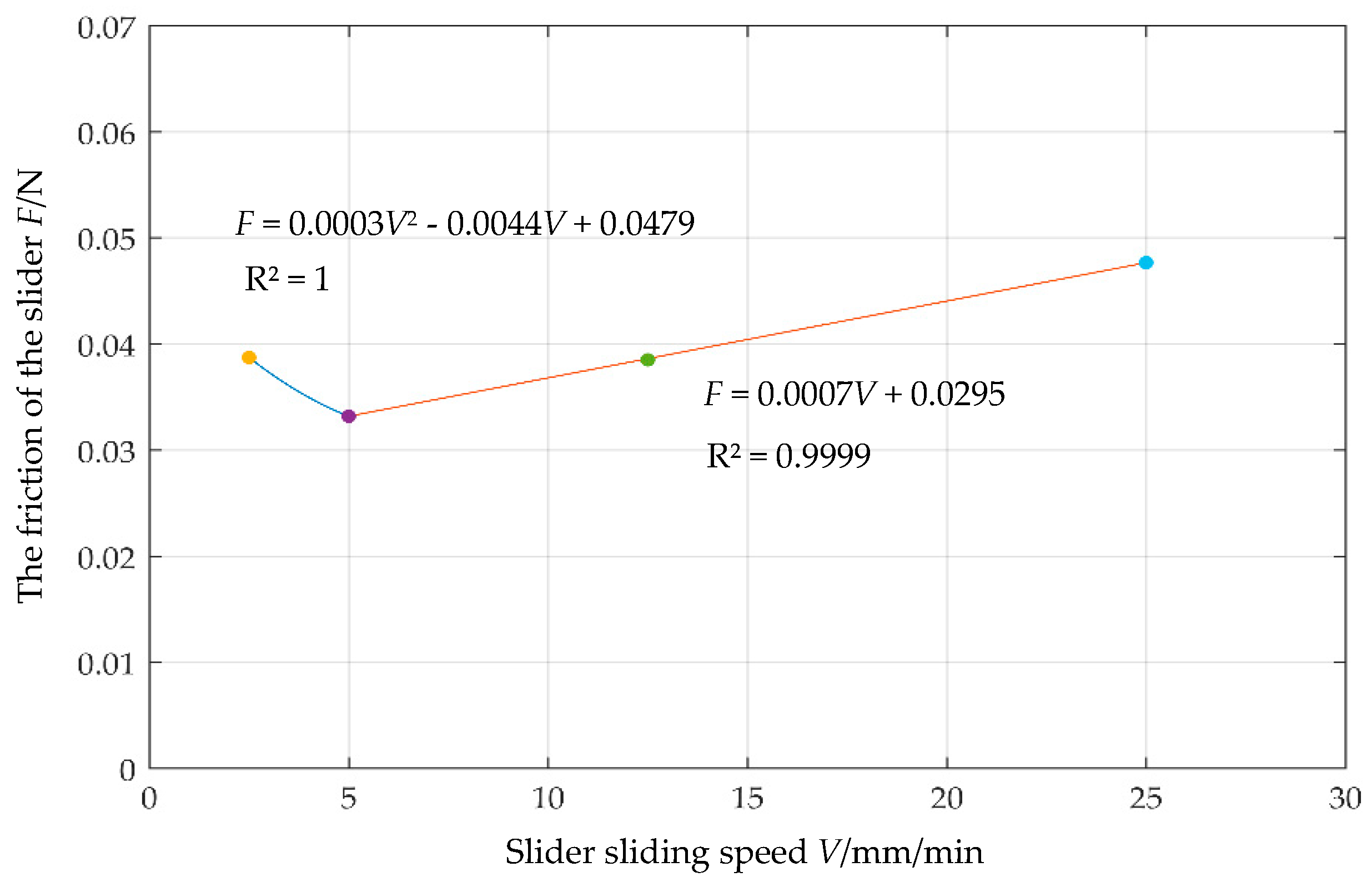
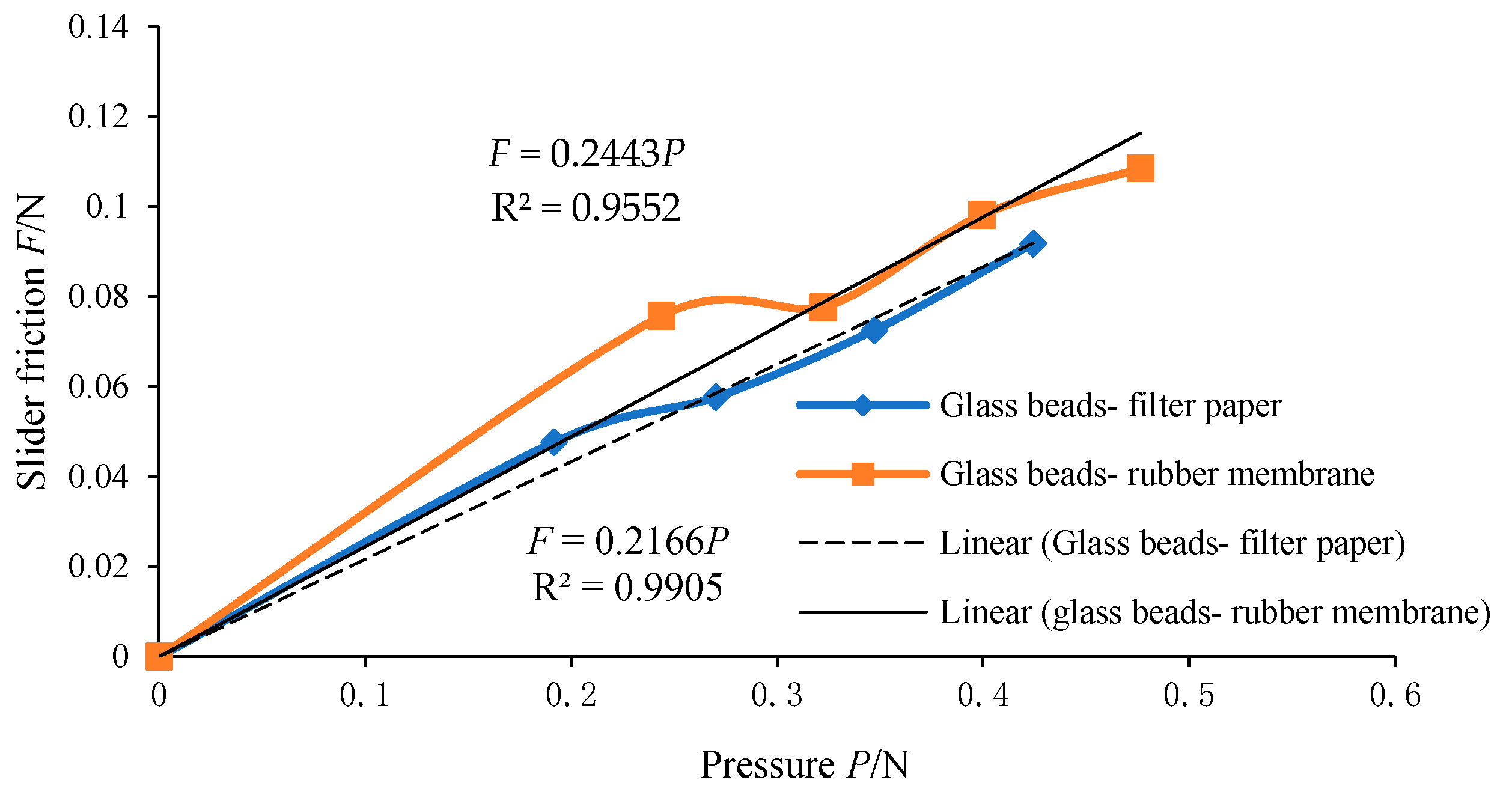

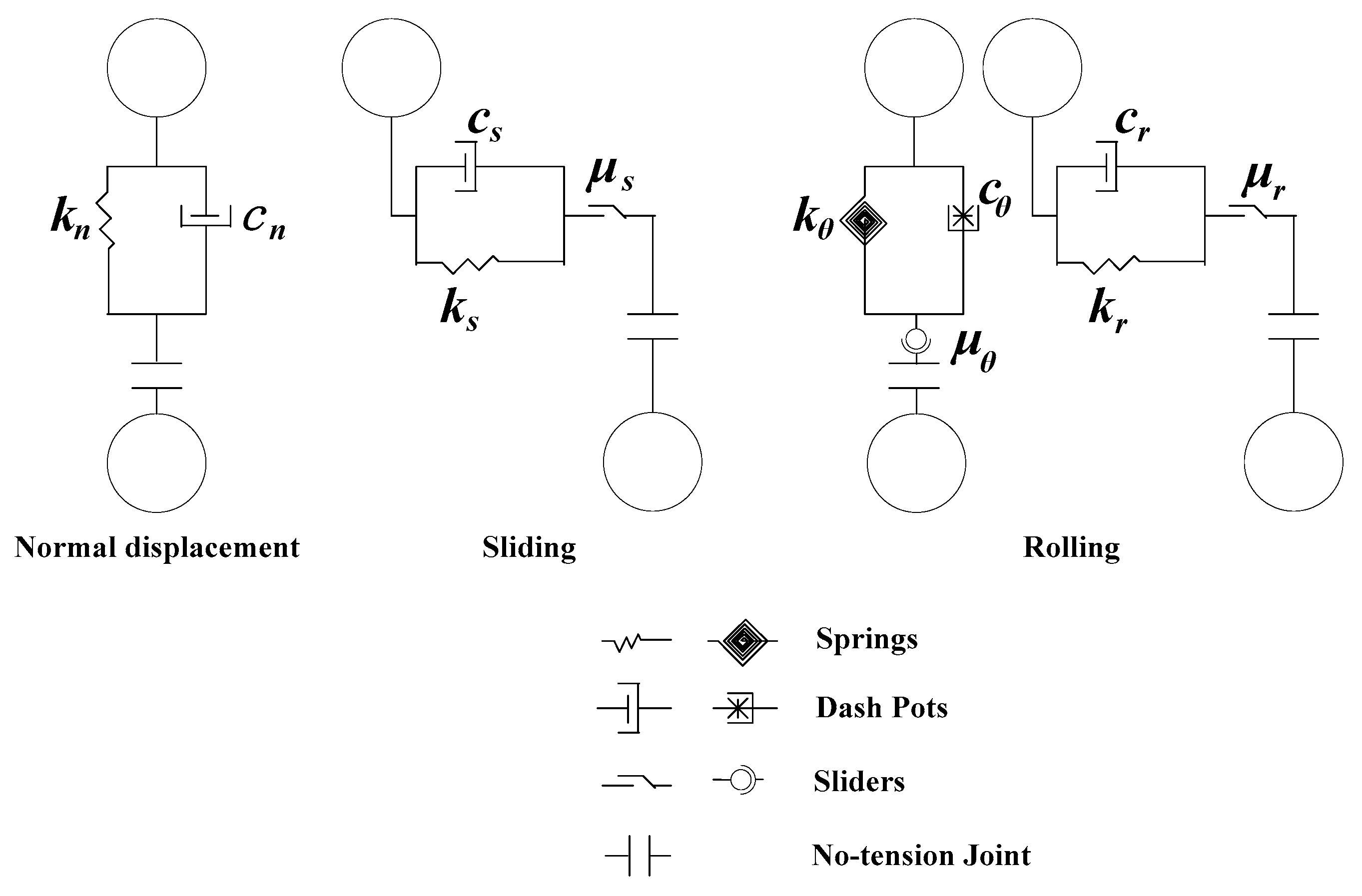
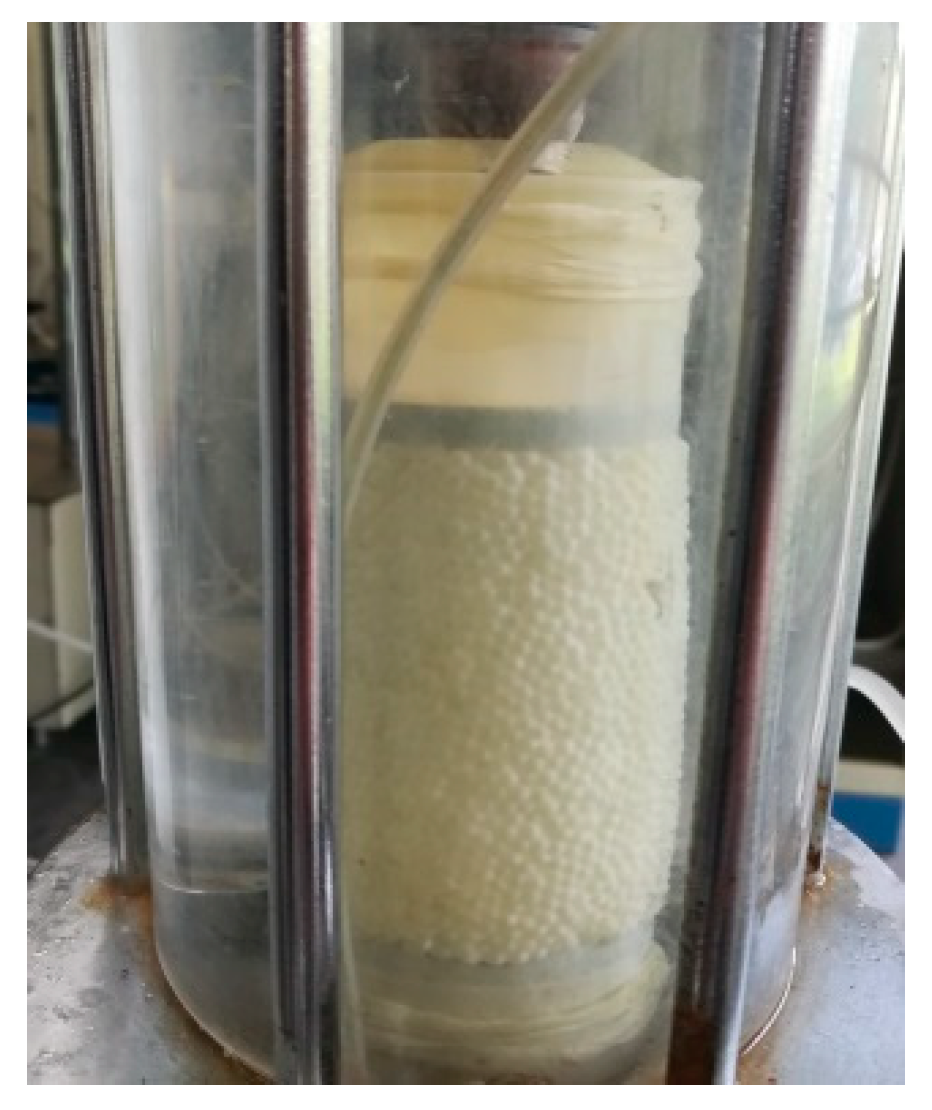
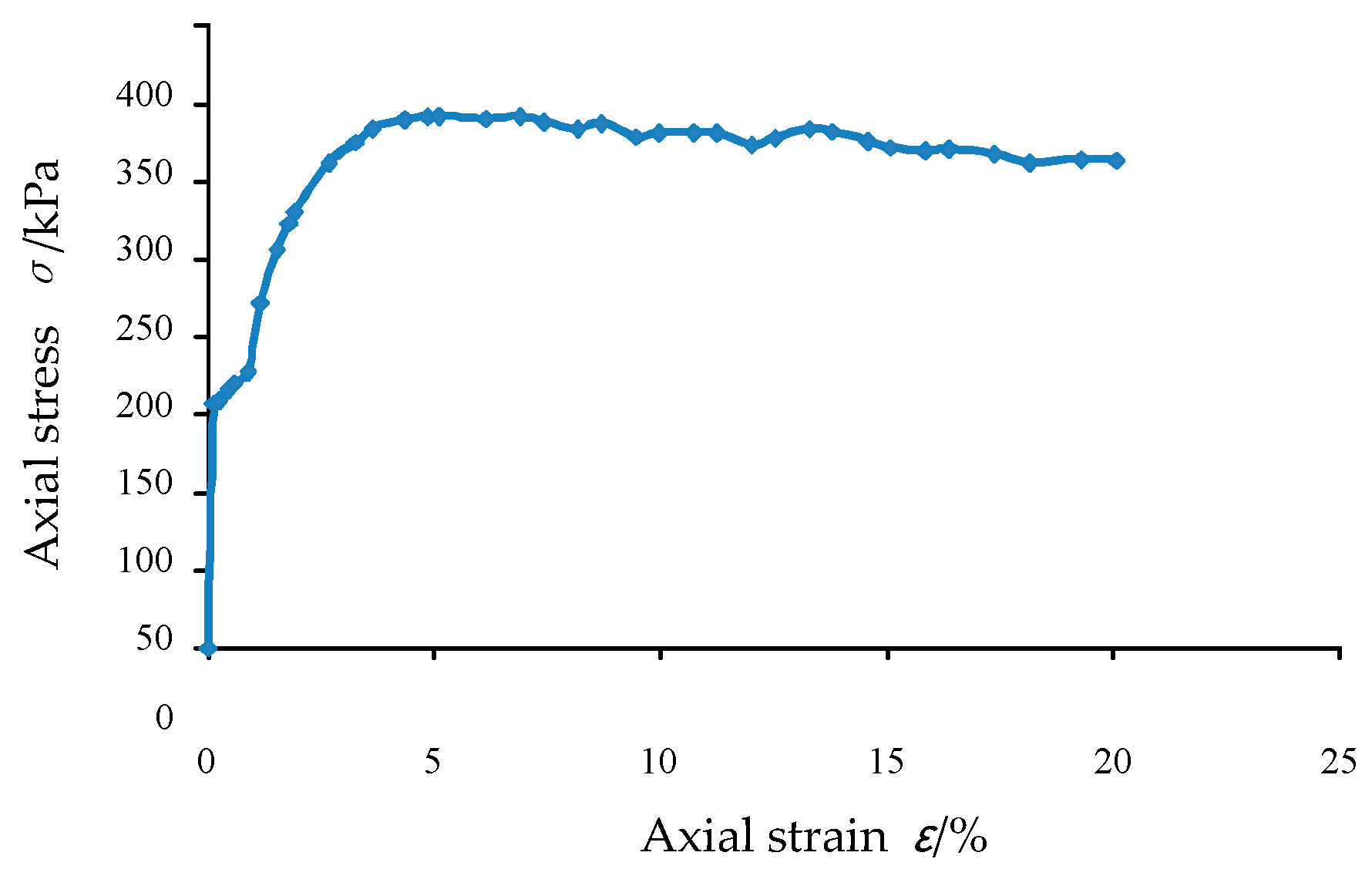
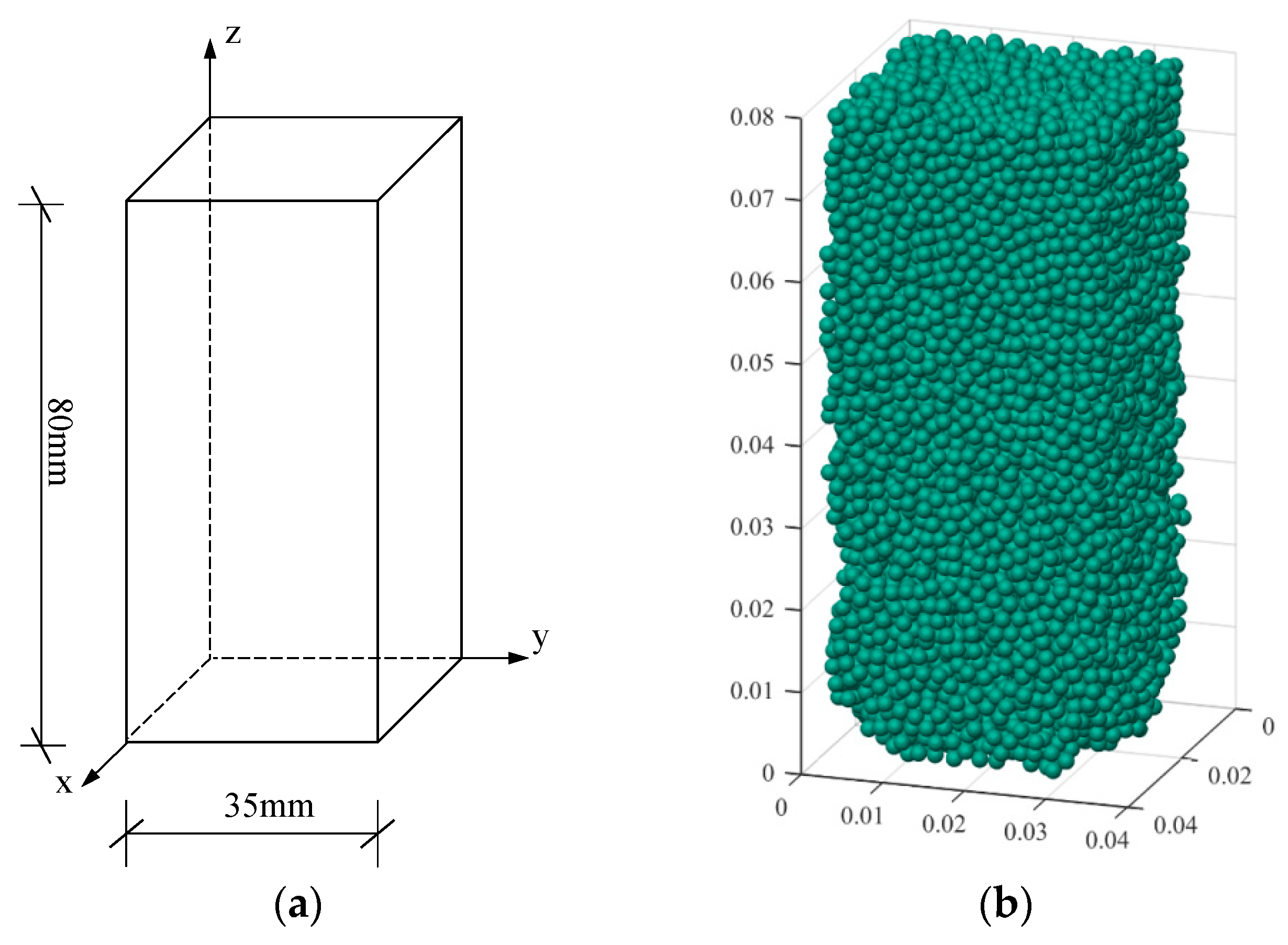

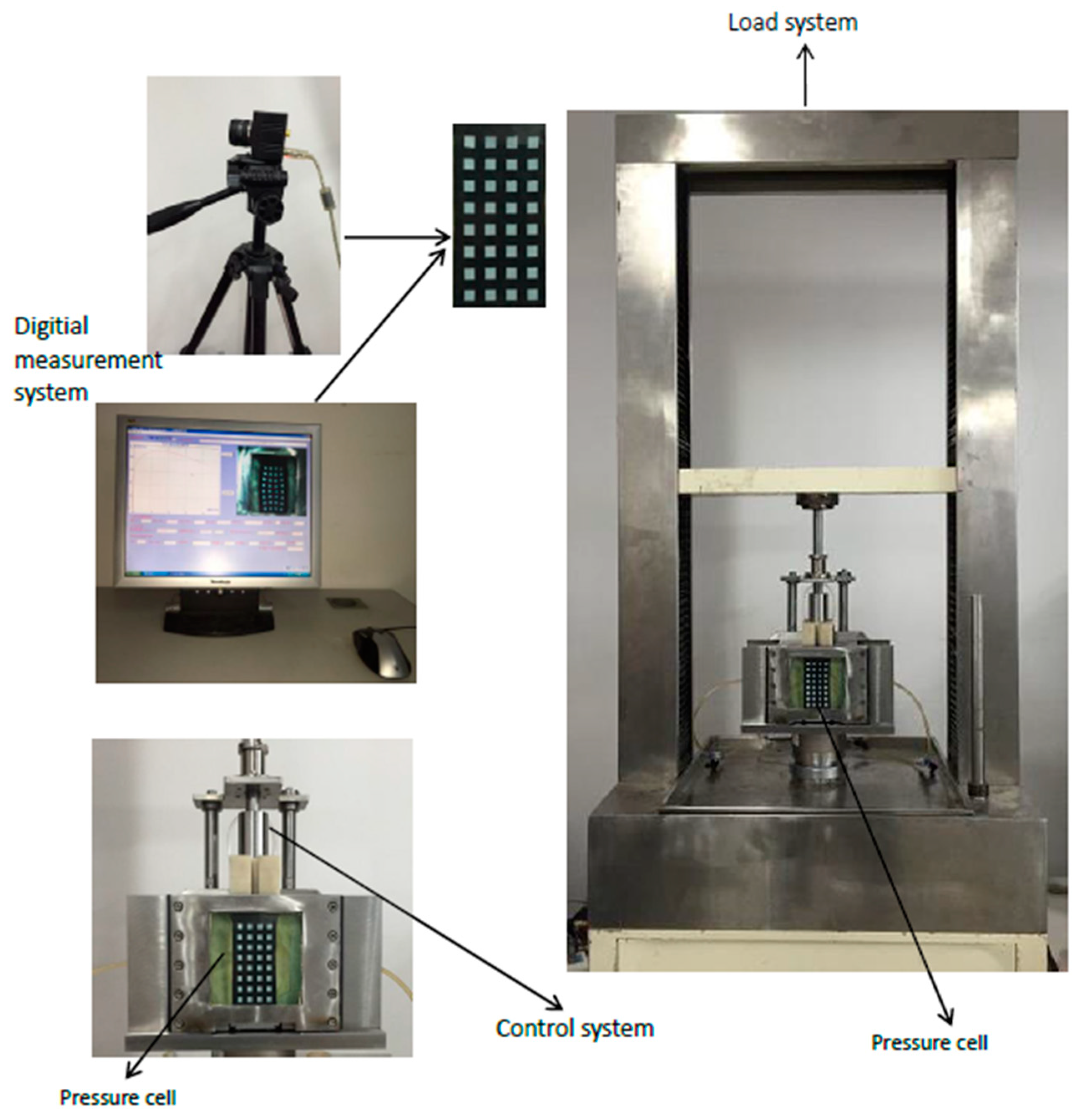
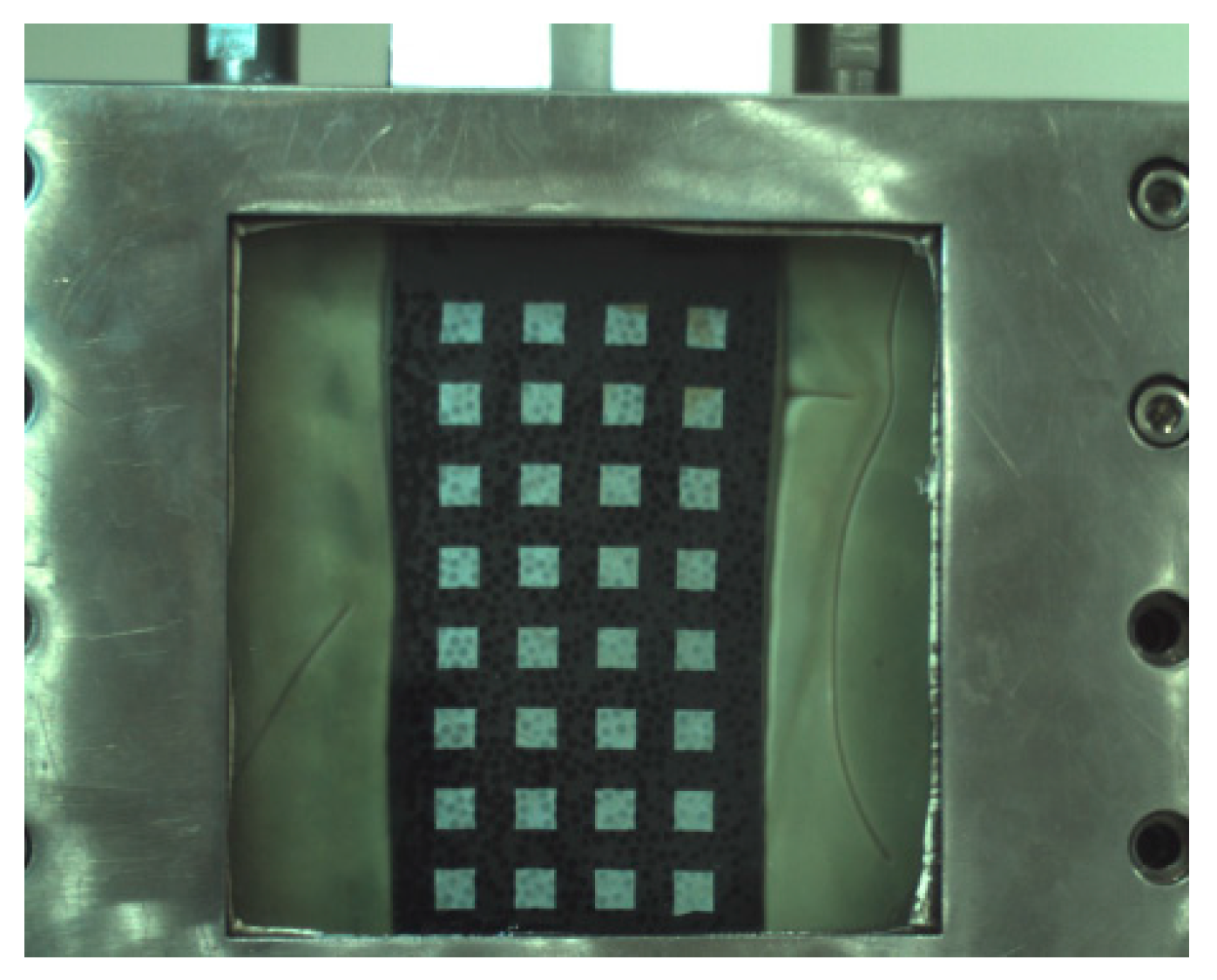
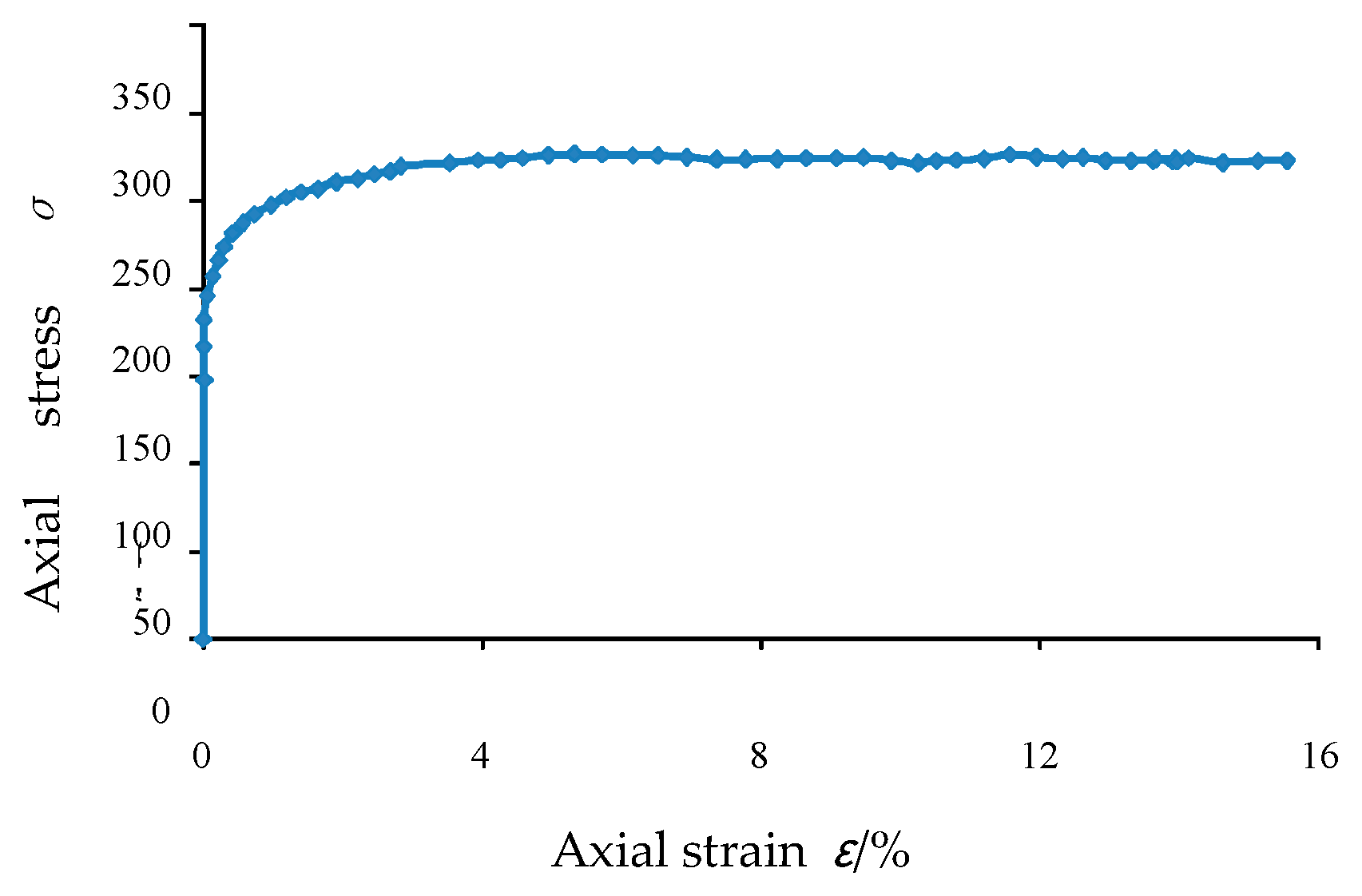

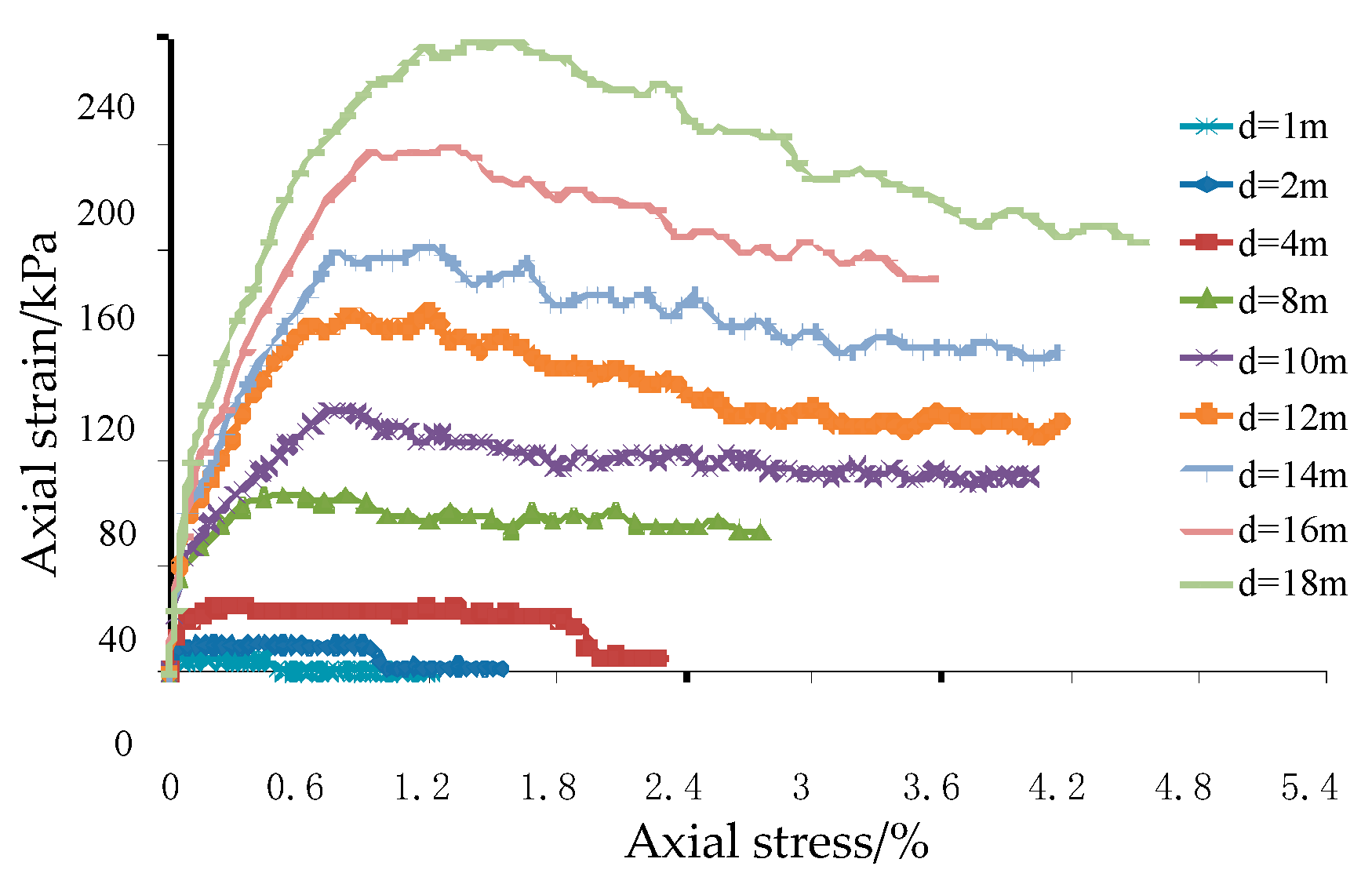
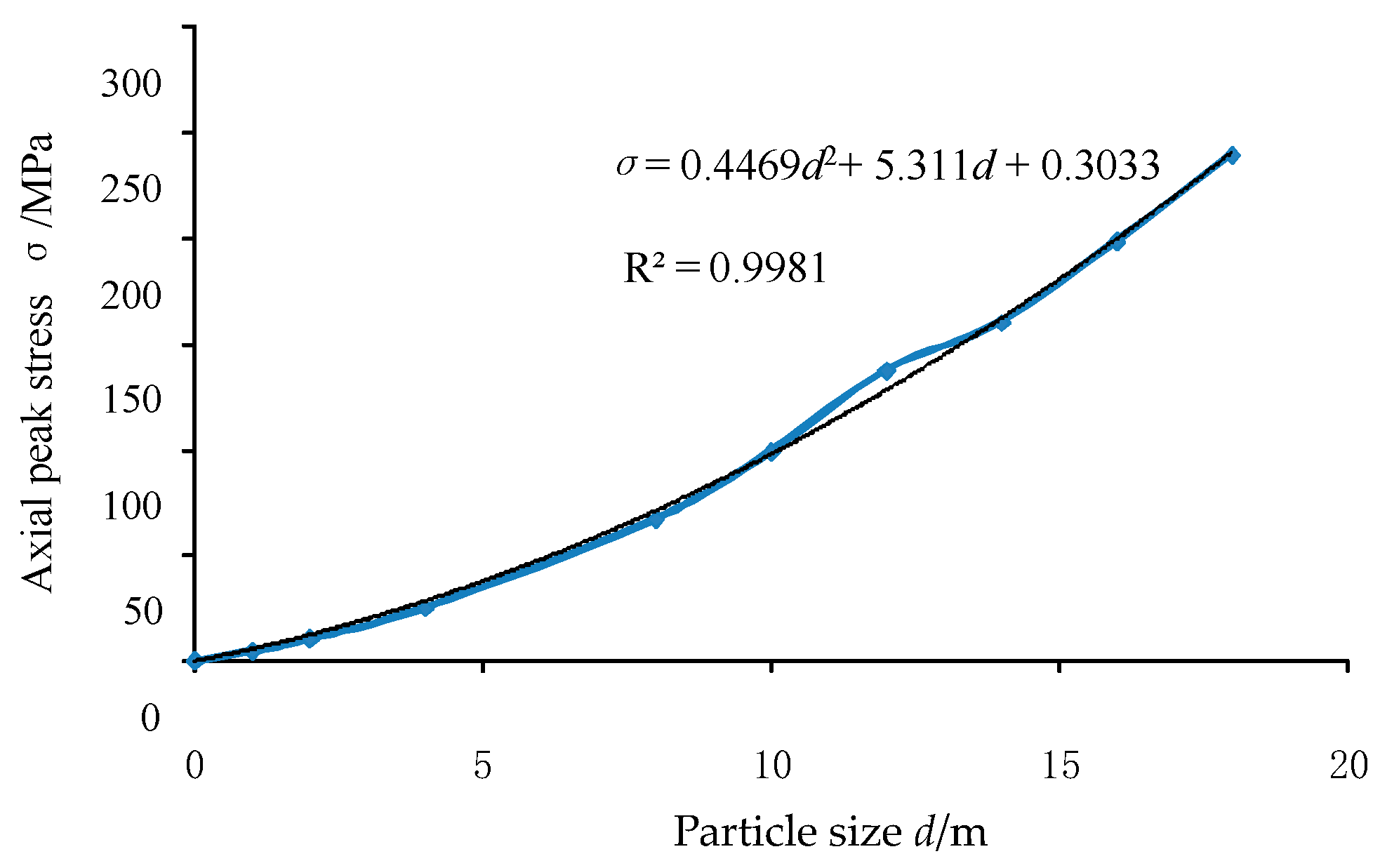
| Indexes of Physical Property | Hardness/ (kg/mm2) | Refractive Index | Circularity | Precision Error |
|---|---|---|---|---|
| value | 720 | 1.50 | 99% | <0.02 mm |
| Materials | Porous Stone | Rubber Membrane | Glass Plate | Filter Paper |
|---|---|---|---|---|
| Thickness/mm | 5.10 | 0.67 | 16.18 | 0.53 |
| Collision Material | Glass Bead | Glass Plate with Rubber Membrane Attached | Porous Stone |
|---|---|---|---|
| Average restitution coefficient | 0.926 | 0.580 | 0.730 |
| Coefficient of Friction between Materials | 25 mm/min Friction Coefficient | Quasi-Static Coefficient of Friction |
|---|---|---|
| rubber membrane | 0.2443 | 0.2116 |
| filter paper | 0.2166 | 0.1791 |
| Parameters | Value |
|---|---|
| Young’s modulus of glass beads E | 46.2 GPa |
| Poisson’s ratio of glass beads υ | 0.245 |
| Density of glass beads ρ | 2500 kg/m3 |
| Friction coefficient between glass bead particles μs | 0.16 |
| Restitution coefficient between glass bead particles COR | 0.926 |
| Friction coefficient between glass bead particles and filter paper μs | 0.18 |
| Friction coefficient between glass bead particles and rubber membrane μs | 0.21 |
| Restitution coefficient between glass bead particles and porous stone COR | 0.58 |
| Restitution coefficient between glass bead particles and rubber membrane COR | 0.73 |
| RNS (Ratio of normal stiffness to tangential stiffness) | 0.5 |
| RZS (Ratio of normal damping to tangential damping) | 0 |
| ARF (a non-dimensional parameter related to the rolling friction moment coefficient) | 0 |
| Parameters | Confining Pressure | Young’s Modulus | Poisson’s Ratio | Density | Restitution Coefficient between Glass Beads | Coefficient of Friction between Glass Beads |
|---|---|---|---|---|---|---|
| value | 150 kPa | 46.2 GPa | 0.245 | 2500 kg/m3 | 0.94 | 0.16 |
© 2019 by the authors. Licensee MDPI, Basel, Switzerland. This article is an open access article distributed under the terms and conditions of the Creative Commons Attribution (CC BY) license (http://creativecommons.org/licenses/by/4.0/).
Share and Cite
Tang, H.; Song, R.; Dong, Y.; Song, X. Measurement of Restitution and Friction Coefficients for Granular Particles and Discrete Element Simulation for the Tests of Glass Beads. Materials 2019, 12, 3170. https://doi.org/10.3390/ma12193170
Tang H, Song R, Dong Y, Song X. Measurement of Restitution and Friction Coefficients for Granular Particles and Discrete Element Simulation for the Tests of Glass Beads. Materials. 2019; 12(19):3170. https://doi.org/10.3390/ma12193170
Chicago/Turabian StyleTang, Hongxiang, Rui Song, Yan Dong, and Xiaoyu Song. 2019. "Measurement of Restitution and Friction Coefficients for Granular Particles and Discrete Element Simulation for the Tests of Glass Beads" Materials 12, no. 19: 3170. https://doi.org/10.3390/ma12193170
APA StyleTang, H., Song, R., Dong, Y., & Song, X. (2019). Measurement of Restitution and Friction Coefficients for Granular Particles and Discrete Element Simulation for the Tests of Glass Beads. Materials, 12(19), 3170. https://doi.org/10.3390/ma12193170




